Table of Contents: Intro & 1920; 1921-1923; 1924-1927; 1928-1932; 1933-1935; 1936-1939; 1940-1945; 1946-1949; 1950-1953; 1954-1956; 1957-1959; 1960-1963; 1964-1966; 1967-1969; 1970-1973; 1974-1976; 1977-1979; 1980-1983; 1984-1986; 1987-1989; 1990-1993; 1994-1996; 1997-1999; 2000-2003; 2004-2006; 2007-2009; 2010; 2011; 2012; 2013; 2014; 2015; 2016; 2017; 2018; 2019; Recap & 2020; 2021; 2022
This week, the 100 Years of Buggy History series takes a look at the 1970s. The end of the decade saw some crazy races, and some even crazier buggies. It also includes one of the craziest incidents ever, involving a dog. But it wasn’t all craziness on the course; there was also a showdown between Sweepstakes and Student Senate. And of course, one of the biggest changes in Buggy history – the introduction of Women’s Racing.
1977
Raceday: Prelims on Friday, April 22 at 9:00am; Finals on Saturday, April 23 at 9:00am
Sweepstakes Committee: Mark Gardner (Chair), Bob Beck (Safety), Ray Sevigny (Design), Anna Safary (Buggy Book)
Race Results: (1) PiKA A – Pi-thon (2:17.8 – COURSE RECORD); (2) SigNu A – Hornet (2:21.4); (3) CIA B (2:24.9); (4) ATO A (2.26.0); (5) SAE B (2:26.8); (6) Beta B (2:28.1)
Design Comp: (1) Beta – Echo; (2) DTD – Delta Queen; (3) CIA – Black Magic
Weather: Dense Cloud Cover, 67-70 Degrees on Friday; Cloudy/Drizzle, 62-65 Degrees on Saturday
Buggy Book: 1977 Buggy Book Link
Prediction Score: 22*/45 (Compubookie)
1977 was one of the wildest years in Buggy history, as the races were full of incidents (both on and off the course). Plus, SAE introduced a mainstay to the course – a buggy called Limo.
- Broadcast Check-in. We like to check in on the state of things in the Buggy world from time to time, and for 1977 we have an update on WRCT’s coverage of the races. WRCT had their radio truck set up near the starting line, but also provided mobile coverage and remote coverage. They broadcast each heat live, and also had a Buggy recap show once the races were over.
- CIA Xi. CIA’s Black Magic proved to be a strong buggy in 1976. But CIA missed the Finals due to the lack of a quality push team. So in 1977 they sought out better pushers…and found them in the form of Theta Xi brothers. Theta Xi elected to stop running their own buggy team, so their top pushers jumped over to CIA. It was a mutually beneficial arrangement that worked out for both groups. CIA was one of 14 organizations to race in 1977.
- Taxi or Limo? SAE officially announced the end of their bike era, as they brought out two previously unraced 4-wheelers. The first, which rolled as their B team in 1977, was The Hustler. Courtesy of Elmo Zoneball, we know that The Hustler’s design was completed over Winter Break 1976, and built and welded over Spring Break. It had an aluminum tube and ladder frame (i.e., a short aluminum ladder with the rivets and rungs removed) and a highly dimpled body for maximum aerodynamic drag. The sides of the ladder were “C” section aluminum, and SAE used a flat frame of 1″ aluminum rectangular tubes to connect the pieces together, with a small gusset plate welded in the center to tie it all together. SAE’s second new Raceday buggy, which rolled as their C team, has become a little more famous. Yes, 1977 marked the first official Raceday of the “New Ken Taxi”, which is more commonly known by its real name: Limo. Limo is described as combining “Lincoln-log construction with battering ram protection to achieve virtual indestructibility”. According to Elmo Zoneball, Limo was initially built in 1974 over a single weekend by Bob Thomas and Tom Cianelli to act as a vintage push practice buggy. The buggy was basically a rectangular plywood sheet, with solid wood side boards for stiffness, using steel soapbox derby axles. Limo was never supposed to see a Raceday, but SAE had so many members in 1977 who wanted to push that they decided to run with it. And that’s how a legend is born.
- Other New Buggies of 1977. SAE wasn’t the only one to roll out new buggies in 1977. Fringe didn’t build a new buggy, but they did pull Baby Leroy out of storage to roll as their B team. KapSig’s buggy Red Baron, likewise, wasn’t new, but they did replace all of the internal components to make it run faster. But several new buggies did made their way out to the course in 1977. The leader of the pack was Beta’s new build, Echo. PiKA built a newer version of their veteran T-2, which fittingly was named Tiger Shark III (T-3). PiLam put together their first real buggy, Sisyphus X, as a test to see what they could come up with for 1978. SDC used technology from the world of kayaking to build their new buggy, Blue Haze. According to 1977 SDC Chair Frank Worbs, it was a mix of carbon fiber and fiberglass with bicycle tires, only opened at the front and was very claustrophobic. Very few people could fit inside, but as he remembers, the entire structure only weighed 7 pounds, which is how they were able to win a future Design trophy. ZBT built their first new buggy, a 4-wheeler called Pegasus (which was also known as “The A&P Special”).
- Compubookie. A couple of changes were made to the predictions in the 1977 Tartan. The first was that the predictions only included Compubookie; there were no more predictions from Sweepstakes members. The other change was that this was the first year that Compubookie included team capsules for a number of teams (still not all of the teams, but more than just the Top 6). Compubookie predicted that a course record would be set, thanks to the late April Carnival at 9am start time, and he believed that more than 1 team would break the then-current record. The final predictions were: (1) PiKA A; (2) Beta A; (3) CIA A; (4) SigNu A; (5) PiKA B; (6) PhiKap A. In my prediction score, I’m being generous and crediting Compubookie for both the Beta and CIA predictions, because (a) these were essentially A teams, and (b) Compubookie didn’t actually include a letter in his predictions unless he predicted more than 1 team from the same org (so PiKA A and PiKA B got letter designations, but the Beta prediction just said “Beta Theta Pi”).
- Who Let The Dogs Out. It’s a known fact that dogs can have extreme reactions to buggies. I can’t explain why, but we’ve seen dogs chasing after buggies as early as 1949. Well, Raceday 1977 got off to an…interesting start that set the tone for how the rest of the weekend was going to go. Heat 1 consisted of ZBT B in Lane 2 and CIA B in Lane 3 (ATO C was assigned to Lane 1, but they scratched before the race). ZBT beat CIA up the front hills and made their way into the freeroll. But shortly after they started the freeroll, a white dog ran from the crowd and “mounted” the ZBT buggy. Some suggested that this was ZBT’s attempt to cross-breed a new, faster buggy with state-of-the-art biological technology. It turns out that this didn’t actually matter to the race, because the starter and timers were not properly aligned, so the heat was considered a “non-run”, with ZBT B and CIA B each being granted rerolls. CIA B’s reroll came at the end of the day on Friday and they put up a somewhat shocking time of 2:24.8, while ZBT B did their reroll on Saturday morning together with KapSig A (see below), earning a slow 2:48. But if anyone has a photo of this ZBT-Canine Encounter, please contact me at bryan.arsham@cmubuggy.org. There are few incidents throughout these 100 years of buggy that I have wanted to see more than this one, and as of yet we have not uncovered any photographic evidence.
- PiKA C Makes Things Interesting. Heat 2 saw CIA A, with Black Magic, in Lane 1, PiKA C’s T-2 in Lane 2, and PiLam A’s Sisyphus X in Lane 3. Onlookers expected this to be an easy CIA victory, and it looked like it would be early, as CIA went into the freeroll well in front. But PiKA C’s Hill 2 pusher, Emmit “The Chute” Reed, gave T-2 a tremendous shove, and as a result PiKA was able to gain throughout the freeroll, catching and passing CIA’s Black Magic at the start of Hill 3. However, that pass came on the curb side of Hill 3, and it ultimately cost PiKA C some time, as the Hill 3 pusher was squeezed out by the buggy and the curb. That allowed CIA, with their A team pushers, to regain the lead and cross the finish line in 2:30.5.
- “B”ack and Forth. Heat 5 was a battle of the B teams: PiKA B (Lane 1), PhiKap B (Lane 2), and Fringe B (Lane 3). PiKA B, with their buggy S-2, got out of the gates quickly and were the first into the freeroll. But something seemed to be amiss with the buggy in the freeroll, and PhiKap B’s Streak was able to pass just before the monument. But PiKA used superior driving to get the better rollout, and PiKA recaught PhiKap at the start of Hill 3. From there, it was neck-and-beck through Hill 3 and most of Hill 4. But PiKA B’s Hill 4 pusher, Bob Russell, was a little stronger and gave PiKA a 3 buggy length lead going into Hill 5. PiKA B’s Hill 5 pusher took that lead and expanded upon it, finishing in 2:29.25, just 0.75 seconds ahead of PhiKap B (it was another 35 seconds back to Fringe B’s Baby Leroy).
- Fringe’s Rough Day. Heat 6 was one of the most highly anticipated heats of the day, with the 3rd and 6th place finishers from 1976, ATO A and Fringe A, duking it out, along with KapSig A. But it turns out that the Heat was exciting for a different reason. ATO A, coming out of Lane 3, had the strongest front hills and was the first into the freeroll, a critical position in this Heat. KapSig A, in Lane 1, pulled off a bit of a surprise by keeping up with Fringe A in Lane 2, and the two went into the freeroll simultaneously. Shortly after they entered the freeroll, Fringe, from the wider lane, started to cut in and collided with KapSig. The collision caused both buggies to crash and not finish the race (the 1978 Buggy Book jokingly suggests that KapSig made an “unsuccessful attempt at driving our buggy through a tree during the competition.” The judges determined that Fringe was at fault for the collision, and therefore Fringe A was DQ’d for contact, while KapSig A was granted a reroll. KapSig A made that reroll on Saturday morning and put up a 2:42.2 time.
- Beta Disaster. Heat 8 had one of the pre-race favorites, Beta A and their new buggy Echo, up against ZBT A in Lane 1 and SAE C in Lane 3. But trouble started for Beta immediately. When the starter announced that there was 1 minute until the start, ZBT and SAE each made their way to the starting line, but Beta was nowhere to be seen. Reports were that Beta’s driver had trouble loading into the buggy while it was in the truck. By the time the starter got to the 10 second countdown, Echo was still nowhere to be seen. Finally, at 5 seconds, the buggy emerged from the truck and started to be carried to the Starting Line, but once they were 20 feet away from the Starting Line, the carrying crew dropped the buggy from waist height and left it there. Bruce Bickar, Beta A’s Hill 1 pusher, tried desperately to turn the buggy so that it was facing up Hill 1 as the race began, but at that point, it didn’t matter. Beta A had been DQ’d for a 5 second violation. The Tartan reports that the reason the buggy was dropped was because people carrying the front of Beta’s buggy were not wearing gloves, and so they were unable to hold on to the hot wheels. Beta A was ultimately granted a reroll in order to earn a time to be eligible for Design Competition, but they were eliminated from the race. To rub things in even more, Beta A’s reroll time was a 2:18.1, the second fastest roll of all time (behind only PiKA A’s run in Heat 10).
- Saving the Best for Last. In the last scheduled heat of the day, the two-time champions PiKA A and their buggy Pi-thon entered Lane 3, where they took on ATO B (Lane 1) and SAE B (Lane 2). And the crowd got all they could ask for. On the front end, PiKA crushed the previous course record, setting the new mark at 2:17.8. On the back end was a very exciting race between two evenly matched teams. ATO B entered the freeroll somewhat close behind PiKA A, but as was their nature, they lost a fair amount of rubber from their tires in the Chute and suddenly the battle was for second. SAE passed ATO at the start of the back hills, and as they reached the Hill 4-5 transition, SAE was slightly ahead of ATO. But ATO’s Hill 5 pusher, Pete Rothermel, was the stronger Hill 5 pusher, and ATO was able to overcome SAE at the last minute, finishing in a 2:26.0 to SAE’s 2:26.8.
- Other Prelim Heats. The April 26, 1977 included a full heat-by-heat recap of Raceday, and we’ve included the interesting ones in full detail above. But for completeness sake, we’ll provide a summary of the others as well (note that the full Finish Times are already listed in our history database and the full heat list is in the 1977 Buggy Book, so we won’t be repeating them all here). Heat 3 was a blowout by Beta B, with their buggy 825 coming out of Lane 2, easily defeating SDC B and KapSig B and setting a time of 2:28.1, which would be the fastest until Heat 9 (SDC B’s time of 2:55.4 is not listed in our database). Heat 4 pitted SAE A against DTD A and their 2nd place design buggy, Delta Queen, and DTD used a strong freeroll to cruise to victory in the heat, with a 2:30.8 time. In Heat 7, PhiKap A, one of the top buggy teams coming into the race, put up a disappointing 2:31.65 time, leaving them in 7th and outside of the Final 6; SigNu B was DQ’d from that same heat for a Pushbar violation. In Heat 9, SigNu A had no problems, putting up the second fastest time of the day with a 2:21.45.
- Exhibitions Delayed. The alumni Exhibition Heats were initially scheduled for 9am on Saturday morning, before the Rerolls and Finals. But the looming threat of rain on Saturday prompted Sweepstakes to make a change, and delay the Exhibition Heats until the end of the day. So the Saturday races began with KapSig’s and ZBT’s reroll. And unfortunately, as you’ll see below, that meant no Exhibitions.
- Finals Dilemma. The 1977 Finals were about as crazy of a Finals as you will ever see. To understand it, I am providing the recap in chronological order:
- Finals Heat 1 – The first heat was a race between the 2nd, 4th, and 6th fastest times from Friday, which belonged to SigNu A’s Hornet (in Lane 2), ATO A (in Lane 1), and Beta B’s 825 (in Lane 3). But thanks to the Beta A DQ on Friday, Beta swapped out their pushers on Saturday so that their A team was pushing the B team buggy. The heavier 825 seemed to have an effect, however, as SigNu led up Hill 1. Beta did grab the lead on Hill 2 and entered the freeroll first, with SigNu about 1 buggy length behind. But in the freeroll, SigNu’s Hornet began to gain on Beta’s 825 until they were neck-and-neck, where they remained until they reached the Chute. As they made the turn, Beta’s buggy, which was on the inside, took a wider line, cutting in front of SigNu and causing a collision. Both Beta and SigNu went into the hay bales. As a result, ATO’s buggy was stopped by the lead truck. SigNu’s driver was taken to the hospital for precautionary x-rays, which were negative. Sadly, the results were not as good for the buggy. Hornet was put in a security van and taken back to their truck, but the end result was that the buggy was damaged beyond repair, forcing one of the fastest buggies on the course into retirement. Beta’s buggy was also damaged but the driver was unhurt. After much deliberation, Sweepstakes determined that Beta was at fault and DQ’d the buggy. Due to the damage to SigNu’s buggy and the driver being taken to the hospital, SigNu was allowed to use their Day 1 time as their final time, and ATO was granted a reroll.

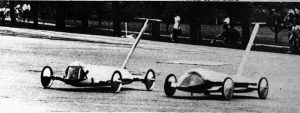
- Finals Heat 2 – The second heat saw the 1st, 3rd, and 5th fastest times from Prelims go head-to-head. Those were PiKA A’s Pi-thon, CIA B, and SAE B. But this time the problem came from the race administration. A faulty cadence call by the starter resulted in a false start. But the teams didn’t realize that there was a false start, so all 3 buggies ran the full course. However, no times were recorded. Instead, it was decided that the heat would be rerun.
- Final Roll – To give the competitors in Finals Heat 2 some time to catch their breath, ATO A was set to reroll first. Running alone, there were no issues in the actual race, and ATO A put up a time of 2:26.8, which was 0.8 seconds slower than their Day 1 time. But apparently the Pittsburgh weather gods were laughing so hard at the day’s events that they started to cry. After beating the weather with the initial 2 Finals Heats, it started to drizzle during ATO’s reroll. The Buggy Chairs met to discuss, and after consulting with ATO’s driver, Sweepstakes decided to cancel the rest of the day. Since not all teams had a Finals time, the Saturday results were wiped out and Friday’s Prelim times were declared final, making PiKA A the winner.
- 1977 Photos. Below are some photos from 1977:

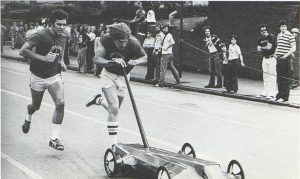
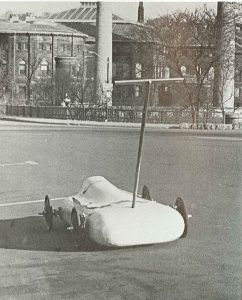

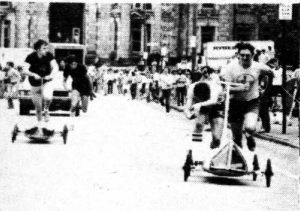

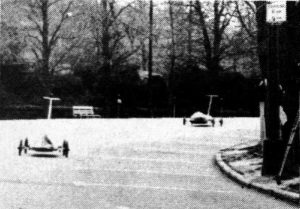
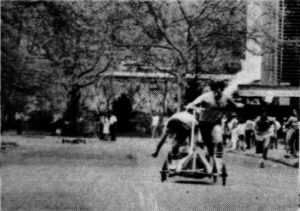
1978
Raceday: Prelims on Friday, April 14 at 9:00am; Finals on Saturday, April 15 at 9:00am
Sweepstakes Committee: Gerd Beckmann (Chair), Mike Gibbs (Safety), Ray Sevigny (Design), Annette Lampe (Buggy Book)
Race Results: (1) Beta A – Echo (2:20.0); (2) PiKA A – Pi-thon (2:21.0); (3) CIA A – Black Magic (2:22.2); (4) SigNu A – Scorpion (2.23.2); (5) Beta B (2:23.3); (6) PhiKap B (2:26.9)
Design Comp: (1) Beta – Echo; (2) CIA – Black Magic; (3) SigNu – Scorpion
Weather: Sunny, 48-52 Degrees on Friday; Sunny, 45-49 Degrees on Saturday
Buggy Book: 1978 Buggy Book Link
Prediction Score: 22/45 (Compubookie); 35/45 (Mike Gibbs, Safety Chair)
1978 saw battles both on and off the course, as PiKA and Beta locked horns on Raceday (in more ways than one) and Sweepstakes battled the Student Senate before the races. And Sweepstakes revised the Finals structure to one that’s still in place today.
- SDC vs. Housing. SDC’s bureaucracy might include a little more red tape than other buggy organizations. In 1977, the Housing Office either took, or lost, SDC’s buggy tools. So SDC had to petition to spend $63 on new tools. We think that the vote eventually passed, though this may have been the result of SDC submitting a letter to Housing to request reimbursement for the new purchases. But SDC wasn’t the only one with something taken. At one point during the year, Beta attended a Chairmen’s meeting and complained that someone had stolen their wheels.
- A Fall Rolls Report. The “Buggy Comments” column from 1977 was no longer a weekly occurrence, but we still got one, on November 8, 1977. It included a recap of fall rolls up until that date – all of 2 practices. The first fall practice, held on October 23, got a late start due to it being the last week of Daylight Savings Time, so rolls didn’t start until 7:30am and there wasn’t much to report. The second fall rolls, on November 6, was a perfect day for rolls, with temperatures in the mid-60s, calm winds, and a long morning. Most orgs weren’t going all out, just getting new drivers trained or veterans back in the swing of things, but PiKA bucked that trend and started going all out early. Beta and CIA were also rolling well. The biggest excitement of the day came from SAE. One of their drivers took the Chute turn too wide and looked like he was going to head straight into the haybales. As the crowd in the Chute scrambled for cover, the driver hit the brakes and was somehow able to stop before reaching the bales. Meanwhile, the Spring weather wasn’t as cooperative; Sweepstakes had permits for push practice beginning the first week of March, and rolls beginning the last weekend of February, but those first couple of attempts were all cancelled due to bad weather.
- W3VC Officially Becomes a Part of Buggy. At this point, W3VC had been running the radios for Buggy for years. But an article in the April 25, 1978 Tartan explains just how important W3VC’s role in Buggy had become. In fact, the job that W3VC did in 1978 is generally the same job that they do today, with members stationed at the Starting Line, the top of Hill 1, by Westinghouse Pond, at Panther Hollow Bridge, in the Chute, and at Scaife Hall, in addition to Net Control. The article does note that “several years ago, a buggy crashed at the Panther Hollow bridge and its driver’s back was seriously injured.” The radio operator summoned the ambulance, but the paramedics were unsure of how to safely transport that type of back injury, so the radio operator used an autopatch (equipment to make a telephone call from a portable ham radio) to call the hospital directly. The driver was safely transported to the hospital where the staff was waiting and the driver was successfully treated. As a note, we don’t know exactly what crash or injury this is referring to (we’re not aware of an injury this serious since 1976, when W3VC began their role in buggy), but it just goes to show the importance that W3VC has played in the history of Buggy.
- The End of Design Competition? An article in the March 21, 1978 Tartan called for students to attend Design Comp, as it was their best chance to see all of the buggies up close. It also noted that each organization was required to enter at least 1 buggy in the Design Competition. But the article also pointed out that for the past several years, there had been discussion as to whether Design Comp was still meaningful in relation to the races. In 1977, 3 of the Top 6 buggies didn’t finish in the top half of buggies, and therefore were ineligible for awards in design, making the connection between Design and Raceday a little more tenuous, and PiKA, who had won the race the previous 3 years, had typically finished towards the bottom in Design. It’s unclear how genuine the debate over eliminating Design Comp was, however, since it seems as though the entire point of the Design Competition is to award unique, well-crafted buggies that may not be the fastest or have the best pushers.
- Why Buggy? The April 11, 1978 Tartan had a full 2 page spread previewing Buggy, including interviews with Buggy people and a general guide for why people should come out to Raceday. Most of the article is pretty generic, but there are a couple of interesting quotes. One buggy chairman remarked that “spectators twenty people deep fill Schenley to see these absurd little things roll past…I will get up for buggy at 4:00 before I will for a class at 8:30”. A driver, Toby Kramer, said that “all the hours of pushing, building and designing – everything you’ve worked for – are caught in those three minutes, and for those three minutes, you’ll suffer the three hundred hours.” The Tartan noted that this statement was made after she had crashed into a tree at 40mph after being sideswiped by another buggy (it’s unclear if this was actually true).
- Buggy’s Status at CMU. If anyone wanted to question Buggy’s standing in the history of CMU, look no further than 1978. As it happens, CMU had a track meet scheduled against Grove City and Bethany on the same weekend as Spring Carnival. But a number of track team members failed to show at the team bus, and the incomplete team was narrowly beaten by Bethany. Why did they miss the buss? Well, the Tartan complained that “it seems a shame that certain athletes feel that pushing a buggy is more important than the commitment to the team and coaches.” But I think we can all agree that, in this case, the athletes are correct and the Tartan is wrong.
- New Finals Structure. Sweepstakes got rid of the Championship and Consolation Heats in 1976 and switched to a time-based placing system, in part to improve safety (by separating the fastest teams into different heats, there was less of a chance of passing and collisions). But since the heats themselves no longer decided the winners, there was also no need to keep 3 buggies in each heat. So to further improve safety measures, in 1978 Sweepstakes changed the Finals to 3 Heats, with 2 buggies in each heat. Finals Heat 1 would be the 3rd and 6th fastest Prelim times, Heat 2 would be 2nd and 5th, and Heat 3 would be 1st and 4th. Not everyone was happy with the change though. A letter to the editor from an alumnus in the April 25, 1978 Tartan called for a return to the old Championship/Consolation Heat structure, laying out 3 reasons: (1) even though the change to 2-buggy heats was made to improve safety, the author claimed that from 1967-1975 there were no accidents in the Championship Finals (there was a minor one in the Consolation Finals resulting in a reroll); (2) the change makes the Finals a time trial, rather than a head-to-head competition, and time shouldn’t be the only factor in determining a champion; (3) using the Championship Finals structure would prevent possible interference with a buggy by a non-participating member of another organization because in the Championship Heat, if he tried to interfere he could end up jeopardizing his own team’s position.
- New Buggies of 1978. Only 3 new buggies were brought out for the first time in 1978, and 2 of them were related. DU built not one, but two buggies, which they conveniently named Duke and Duchess. Both buggies had four-wheel independent suspension, four-wheel braking and four-wheel steering. And KapSig built a new buggy in addition to rebuilding their veteran, Red Baron after it suffered damage on Raceday 1977. We don’t know exactly how much the new KapSig buggy cost to build, but we have a guess – $34.95.
- Predictions. The April 11, 1978 Tartan printed two separate prediction articles. One was the typical Compubookie predictions, while the other was provided by Safety Chair Mike Gibbs. Compubookie probably should have stayed home this year, because he was dusted by Mike Gibbs. Mike nailed the top 4 in order on his way to 35 points, while Compubookie only got the top 3 (but in the wrong order). Compubookie noted that the poor Spring weather made practices almost non-existent. The final predictions for Compubookie were: (1) PiKA A; (2) Beta A; (3) CIA A; (4) ATO (with a comment about ATO actually being TriDelt?); (5) PhiKap A; (6) SigNu A. Meanwhile, Mike Gibbs went with (1) Beta A; (2) PiKA A; (3) CIA A; (4) SigNu A; (5) ATO A; (6) Beta B. Compubookie also ranked the B Teams, putting them in the order of Beta B, PiKA B, ATO B, CIA B, PhiKap B…and then KapSig A.
- Fringe Takes A Flier. We’re not sure exactly what happened to it, but something appears to have happened to Fringe’s Flying Buttress shortly before Raceday. Whatever it was, it knocked Flying Buttress, and as a result Fringe, out of contention in 1978, as Fringe was forced to use Baby Leroy as their A team buggy (and scratch their B team).
- The Wind Effect. 1978 was the perfect example of why you might want to use wheel covers. According to Tom Wood, there was a significant wind effect during the race on Friday, as a severe wind was blowing strongly in the Chute. This wind significantly slowed some of the buggies. But CIA, with their covered wheels (thanks to the design of Black Magic), was affected the least, and the result was the fastest time of the day.
- Prelim Heat Recap. The 1978 Tartan includes a short heat-by-heat summary, but since the Heat Schedule is listed in the 1978 Buggy Book (linked above) and the times (other than ZBT A’s 2:57.1) are listed in the BAA History Database, there’s no point in rehashing the ones that consist of “Buggy X beat Buggy Y”. But there were still a few interesting Heats worth mentioning. Heat 2 was a battle between ZBT B’s Mountain Oyster No. 13 Le D (bike) in Lane 1 and DU B’s Duchess in Lane 3, but the battle didn’t last very long. ZBT’s bike lost control at the top of Hill 2 and crashed, earning a DNF and leaving DU B to finish the heat alone. Heat 4 was initially supposed to pit CIA A’s Black Magic, in Lane 3, against KapSig A and DU C. However, both KapSig and DU scratched their rolls, leaving CIA to compete against itself. That didn’t seem to bother CIA though, as they clocked in at 2:20.8, the fastest time of the day. Heat 5 ended up with just Beta B’s 825 and PiKA C’s T-3, as Fringe B was forced to scratch (see above), and similarly, Heat 7 only paired Fringe A’s Baby Leroy and SDC B, as SigNu scratched their B team earlier in the week. Heat 9 had a similar scratch, leaving just Beta A’s Echo to battle CIA B’s Streetcar Named Desire, but the scratch wasn’t voluntary. DU A was scheduled to be the third buggy, but they made changes in their steering and braking systems prior to the race without notifying the Safety Chair, and therefore they were DQ’d. Heat 8 had some excitement, as SDC A and DTD A were closely bunched, both traveling behind PiKA B. DTD ended up interfering with SDC A, earning SDC a reroll and DTD a DQ for interference (though DTD also failed Drops, so they were double-DQ’d). PiKA B’s time was only good for 7th, so they also requested a reroll as a result of the interference, but Sweepstakes determined that they were not affected as they were too far in front when the interference occurred.
- The Exciting Prelim Heat. Safety Chair Mike Gibbs told anyone reading his predictions in the Tartan that “Heat 10 should not be missed.” It turns out, he was right. The Heat, which consisted of SigNu A’s Scorpion in Lane 1, SAE A’s Hustler in Lane 2, and ATO A’s new buggy Eagle (which we believe would be renamed to Dark Horse) in Lane 3, was neck-and-neck up the front hills. And because they went up the front hills together, the 3 buggies all went into the freeroll side by side. There was some jockeying for position between the buggies, and even some bumping, but all 3 drivers maintained control and completed the race. In the modern era, the bumping might have resulted in a DQ and/or rerolls, but in 1978, the times all stood.
- Alumni Times. Once again, Sweepstakes ran alumni heats in 1978, but instead of these being Exhibitions, they were actually considered their own division. In total, 4 alumni heats were run, but it wasn’t really a fair fight. Heat 1 had just PiKA’s alumni, consisting of most of 1977’s course record-setting push team, so it’s no surprise that PiKA would win the alumni contest as well, in a time of 2:28.3. But that wasn’t enough. More PiKA alums were running in Heat 4 and put up the 2nd best time, a 2:34.4. And even more PiKA alums ran in Heat 3 and earned the 3rd best time, a 2:37.8. PhiKap’s alums, also in Heat 3, were next in 2:39.3. The closest of the alumni races came from Heat 2, where SAE and Beta battled back and forth before SAE finally edged out Beta, with a 2:43.2 to Beta’s 2:44.4. The remaining times were more SAE alums (2:51.1, Heat 4), KapSig (2:55.2, Heat 2), and DU (3:46.2, Heat 3).
- Unique Buggy Finds Its Way to the Course. Even though there were only two exhibition heats, there was another unique buggy and team who showed off their stuff on the course. The “organization” Lambda Sigma Delta (get it?) brought out a trippy buggy design known as Moose. According to Christopher Koenigsberg, one of the builders, Moose was created by some friends in a co-ed apartment dorm. They had constructed the moose, and one day someone decided to turn it into a “buggy” by mounting the moose on a shopping cart. It may not have raced, but it certainly made its appearance known on the Buggy course, though some may not have believed what they were seeing, as the moose was being pushed in the opposite direction on the course in between heats, with the team yelling “Where’s the starting line?” Similarly, the Campus Printing Office decided to get involved in Buggy by showing off their “buggy”, a mailroom cart that they brought from their offices.
- Women Break Through. Officially, there were 2 “fun” heats, which we now consider Exhibitions. The purpose of these heats were to allow more participation from the student body generally. In the first Exhibition Heat, Pi Lambda Phi entered what they claimed to be the “first all girl push team” (though as you know, if you’ve been reading this series, there have been several women’s teams in the past, including KapSig’s Little Sisters in the early 1970s). The PiLam women’s team finished well behind CIA and DTD in their heat, putting up a time of 4:07.3, but it wasn’t the time that mattered. The creation of an all-female push team in 1978 prompted the Buggy community to consider the idea more seriously, and by 1979, women’s racing wouldn’t just be sequestered in an exhibition heat. Meanwhile, the second heat officially pitted DTD, SDC and KapSig against each other.
- Finals Drama. Finals Heat 1 was pretty uneventful. SigNu A’s Scorpion reportedly rolled faster in the freeroll and had a better rollout, but Beta A’s Echo had the better pushers and won the Heat in 2:20.0. The real drama came in Finals Heat 2. PiKA A’s Pi-thon and Beta B’s 825 went up and over the front hills together, with Beta taking a wide line (right side of the road) and PiKA taking a more traditional line. But as PiKA cut across to the right side of the road, Beta moved out slightly, and the two buggies collided. The buggies bumped multiple times, and at one point, the protruding right wheels of PiKA’s Pi-thon locked up with the protruding left wheels of Beta’s 825. The drivers did not slam on the brakes, but PiKA’s driver, Jim Curran, was eventually able to separate from Beta’s buggy and then came to a safe and controlled stop. The Safety Chair noted that in a change for 1978, drivers were encouraged to discuss their lines with their opposing drivers so that everyone would have a good idea of where the other buggies would be on the road and enable safer passing. Sweepstakes determined that neither buggy was at fault in the incident, and both buggies were granted rerolls. In the reroll, PiKA and Beta stayed separated, and PiKA won the heat in a 2:21.0.
- More Finals Drama. Finals Heat 3 wasn’t without drama as well. CIA A’s Black Magic defeated PhiKap B’s Shadow by 4.5 seconds. But immediately after the race, PhiKap filed a formal protest, claiming that CIA’s driver drove an unsafe course and bumped PhiKap multiple times, causing interference with PhiKap’s buggy. However, Sweepstakes decided to reject the protest. The Tartan reports that had the PhiKap driver hit the brakes, PhiKap would have been granted a reroll. However, because the driver did not stop, a reroll was not granted.


- 1978 Photos. Below are some photos from 1978.



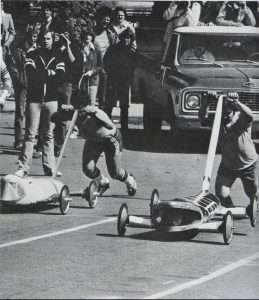
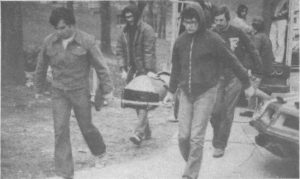
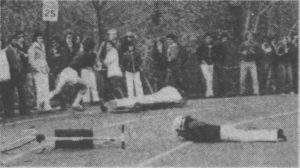
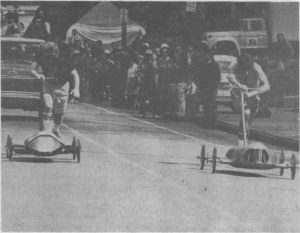
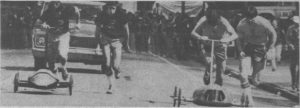
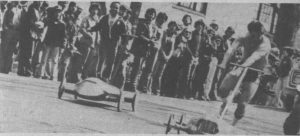


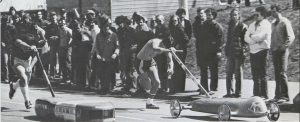
1979
Raceday: Prelims on Friday, April 20 at 9:00am; Finals on Saturday, April 21 at 9:00am
Sweepstakes Committee: Marianne Dwyer (Chair), Dave Lamont (Safety), Tim Bracco (Design)
Men’s Results: (1) Beta A – Echo (2:18.4); (2) PiKA A – Pi-thon (2:19.0); (3) PiKA B – Stingray (2:24.2); (4) SigNu A (2.25.7); (5) ATO A (2:28.4); (6) CIA A – Black Magic (N/A – DQ)
Women’s Results: (1) SDC (3:11); (2) SWE (3:37.9); (3) PiLam (3:46); (4) CIA (DQ; 3:04.7)
Design Comp: (1) Beta – Echo; (2) SDC – Blue Haze; (3) DTD – Cyclone
Weather: Sunny, 51-61 Degrees on Friday; Sunny, 60-70 Degrees on Saturday
Buggy Book: 1979 Buggy Book Link
Prediction Score: 23/40 (Crystal Baller)
1979 brought the introduction of Women’s Racing to Buggy, and there was plenty of drama in that first running. Meanwhile, there was plenty else going on in the world of Buggy as well.
- Roads Worsen. It was only 3 years prior that the freeroll had been paved, but by 1979, the harsh Pittsburgh winters had caught up to them. A Letter to the Editor in the March 13, 1979 Tartan specifically criticized the road conditions, noting that “craters are lurking everywhere” on Hill 2, and that there are “ravines and pits” so deep that they could demolish a car going 35mph; if a buggy hit one of these potholes, it would disintegrate. Before Fall rolls started, Sweepstakes Chair Marianne Dwyer contacted the City and got them to patch some of the worst potholes. But even where the City had patched the holes, the patches themselves were so rough that they were almost as bad as the holes. The letter called on the CMU community to reach out to the Mayor’s Complaint Department to get the roads paved. Safety Chair Dave Lamont echoed the sentiment, saying that “we’ve had way too many accidents this year, and all of them have been directly or indirectly caused by potholes.” The potholes have either bent or broken axles, caused the driver to lose control, or caused the driver to swerve to avoid the potholes, colliding with another buggy. Both Beta and PiLam had accidents during Spring Rolls as a direct result of the potholes.
- Push Practices. Push practices had been conducted for a while now, but for 1979, we know exactly when they were. Sweepstakes had obtained permits for push practice from Sunday-Thursday, from 11pm-7am, beginning on March 5 and ending on April 18. The condition of the permits was that traffic could be held for up to 10 minutes.
- Design Comp Changes. The process for Design Competition changed slightly in 1979. In total, 16 buggies entered the Design Competition. Each buggy would be evaluated on its own for a 15-20 minute period. After that period, the judges select their top 6 buggies, and then those 6 are reviewed as a group for a 45-60 minute period. After that final review period, the judges make their decisions on who will win Design Competition.
- Buggy For The Commoner. 1979 saw Buggy get some coverage to help promote it to the non-Buggy participant. The April 17, 1979 Tartan went all out on buggy, with featured articles about the various aspects of Buggy, entitled “Pushers ignite buggies”, “Speed entices drivers” and “An observer looks at the buggy phenomenon.” There was also an full page interview with Dave Fiedler, the PiKA Chairman/Driver, and an interview with Sweepstakes Chair Marianne Dwyer, about why they do Buggy and what to expect in 1979. It also reprinted an article that had run in an issue of Mechanix Illustrated entitled “Buggy Fever: A Unique experience for everyone”. The Mechanix Illustrated article explained what a buggy is; essentially vehicles built with fiberglass and lightweight steel or aluminum frames that can cost up to $5,000. The article states that buggies are typically 24” or less in height, including 6” of ground clearance, with a 4’ wheelbase and a total length of 5’8” (with an average driver at 5’5” and 100 lbs.). It also notes that the wheels were originally 24” bicycle wheels, but those have mostly been replaced by 12” chemically-coated rubber, and the wheels are heated before the race to retain speed. I do want to point out one flaw in the Tartan articles, as the driving article stated that to pushers, “drivers are expendable but buggies are not”, which may have been the feeling in 1979 but certainly isn’t today.
- Another Unique Buggy on the Course. For the second year in a row, a unique buggy and organization showed up on the course. The Campus Printing Office decided to get involved in Buggy by showing off their “buggy”, a mailroom cart that they brought from their offices.
- SDC Runs Into Trouble. During the last practice session prior to Raceday, SDC had an accident. We don’t exactly what the incident was, but the driver was bruised and was taken to the hospital. SDC agreed to pay for any costs beyond what insurance would cover, and the team vowed to get the buggy repaired before Raceday.
- New Buggies of 1979. Only a couple of new buggies hit the course in 1979. DTD produced a sleek purple vehicle named Cyclone, complete with a wooden pushbar and spoked tires. PiKA put out their first new buggy in a few years, and the first with a new name in a while, when they introduced Stingray to the course. PiLam decided to reach back in time to duplicate one of the fastest buggies in history, Beta Sigma Rho’s The Dolphin. PiLam’s new 3-wheeler was named Blue Dolphin in its honor. And based on the 1979 Buggy Book and SigNu’s t-shirt, it appears that SigNu rolled out a new build as well. That new buggy adopted the name of SigNu’s favorite slogan: ESP.
- Buggy Predictions. Compubookie took the year off, so instead the Tartan found an alternative prognosticator, “Crystal Baller”. Crystal predicted the following: (1) Beta A, (2) PiKA A, (3) CIA A, (4) PhiKap A, (5) SigNu A, (6) SAE A. Meanwhile, Sweepstakes Chair Marianne Dwyer also gave her predictions, though not in order. She also selected Beta, PiKA and CIA as her top 3, with SigNu, PhiKap and SAE on the bottom half of the podium.
- PhiKap Chooses Poorly. PhiKap ran 3 teams in 1979. As many Buggy people know, the assignment of which buggy races for which team can be almost as important as determining which pushers are on the team. And in 1979, PhiKap chose very poorly. Their A team, coming out of Lane 2 in Prelims Heat 4, was the slowest of their 3 teams, clocking in a 2:37.5 (versus a 2:33.4 for their B team and a 2:33.7 for their C team). We don’t know which buggy they chose to use in 1979 as their A team, but they vowed to correct the mistake in 1980 (so we assume Shadow was not their 1979 A team buggy, since Shadow rolled as the A team in 1980).
- CIA’s Struggles. CIA was pegged as one of the top contenders in 1979, after back-to-back third place finishes. But 1979 wasn’t their year. They had apparently planned for a C team during heat selection (if the 1979 Buggy Book is to be believed), but that C team never materialized. Their B team suffered one of several incidents on Raceday, as Streetcar Named Desire suffered a wheel malfunction and spun out in the Chute. Streetcar crashed again on Saturday during the alumni heat, and as a result the CIA women’s team was disqualified, as discussed below. This left CIA’s lone hope with their A Team and Black Magic. In Prelims Heat 8, the A team put together a monster run, clocking in with the second fastest time of the day at 2:20.8. This placed CIA A in Finals Heat 2, where they were paired up against PiKA B and their new buggy, Stingray. CIA won the battle up the front hills and into the freeroll, but the buggies were tightly drawn in the freeroll. As Black Magic reached the Chute turn, something went wrong with the buggy’s steering and a defective wheel part finally gave out. The buggy started to make the turn but ended up spinning out and doing a 180 in the Chute. PiKA’s buggy, which was right behind CIA, was in the process of making their Chute turn when CIA spun and had no room to maneuver away. The result was a head-to-head collision of PiKA’s Stingray and CIA’s Black Magic. Thankfully, neither driver was injured, but the shell of Black Magic was badly damaged. Sweepstakes determined that CIA was at fault for the crash, and therefore DQ’d CIA for contact, placing them 6th and granting PiKA B a reroll. PiKA’s buggy was dented in the front and would require approximately 30 minutes worth of repair, but Sweepstakes offered PiKA the opportunity to use its Prelim time in place of a Reroll and PiKA accepted, which was enough for PiKA B to earn the 3rd place trophy.
- Fringe Struggles Too. It wasn’t just CIA that had bad luck on Raceday 1979. Fringe was also the recipient of some misfortune. Prelims Heat 8 was a battle of independents, as Fringe A and their buggy, Flying Buttress, came out of Lane 3 against CIA A’s Black Magic in Lane 1 and SDC A’s Blue Haze in Lane 2. At some point during the race, Flying Buttress ran into a pusher from one of the other teams, and the contact damaged one of Fringe’s axles, knocking Fringe out of the race. The details make it seem like this may have happened on the front hills with Fringe coming out of their lane, because Sweepstakes elected to DQ Fringe for the contact. Fringe protested the DQ, but Sweepstakes did not change the decision and Fringe was eliminated from the competition. However, Fringe was permitted to reroll on Saturday morning because Flying Buttress had placed in the Top 6 for Design Competition, and the time was needed to determine whether they would be eligible for a Design trophy.
- A Close Call. Prelims Heat 9 was a very tight battle between ATO A’s Gander in Lane 1, PiKA C’s T-2 in Lane 2, and SigNu A in Lane 3. ATO and SigNu were neck-and-neck up the front hills and went into the freeroll pretty evenly. But SigNu either got a slightly better push, or had the slightly faster buggy, and as the two buggies reach Westinghouse Pond where the buggies cross over the street, SigNu had pulled narrowly ahead. And the lead was narrow indeed. SigNu’s Scorpion crossed over a mere inches in front of ATO’s Gander and wouldn’t look back, winning the heat by over 5 seconds. But ATO lodged a formal protest immediately after the race, claiming that SigNu made an illegal pass, cutting them off and leaving just 6 inches between the buggies when the rules required that passes occur more than 2 buggy lengths apart. Sweepstakes reviewed the incident and disallowed the protest, letting the times stand. The two buggies would end Friday with the 5th and 6th fastest times, both advancing to the Finals.
- Exhibition Disaster. The poor road conditions made it difficult for some teams to navigate the course successfully, but the main source of problems in 1979 seems to have been mechanical issues. DU A’s Duke had its steering column lock up during the middle part of the freeroll and the buggy crashed into the monument during Prelims Heat 10. DU B also seems to have not recorded a time, though we don’t have the reason (it was either a DNF or a scratch). But a surprising number of incidents occurred during the normally fun Alumni/Exhibition heats. PhiKap’s alumni heat ended in disaster, as the buggy’s steering fell apart during the heat and PhiKap was unable to complete the course. And as noted above, CIA’s Streetcar Named Desire also crashed during the alumni heats in what would become its final career roll.
- A New Division in Buggy. Women had been given several opportunities to push buggies in Exhibitions prior to 1979. But PiLam’s successful all-woman push team in the 1978 Exhibitions seemed to reach a tipping point that had not previously been reached. By 1979, there were enough women at CMU interested in pushing a buggy that Sweepstakes made the decision to expand, creating a Women’s division in addition to the Men’s division. That first year, four teams came out to compete for the trophy, and they raced in 2 heats of 2 on Saturday (after the Exhibitions and prior to the Men’s Finals). In Heat 1, CIA took on PiLam, and in Heat 2, SDC battled the Society of Women Engineers (SWE). Neither heat was particularly close, as CIA won Heat 1 in a time of 3:04.7 to PiLam’s 3:46, and SDC took Heat 2 with a time of 3:11 against SWE’s 3:37.9. The times made it so that CIA was the winner of the first ever Women’s Races…but not so fast. The buggy that CIA planned to use for the Women’s Finals, Streetcar Named Desire, was damaged in an Exhibition heat crash shortly before the Women’s race and it could not be fixed in time. Meanwhile, Black Magic was badly damaged from Friday’s crash, leaving CIA without a buggy for their Women’s heat. KapSig was kind enough to lend CIA their buggy, $34.95, and driver for the Women’s race. But this change led SDC to lodge a formal protest and Sweepstakes had no choice but to DQ CIA for a Roster violation. So the official first winner of the Women’s Races was SDC in 3:11.0. The team consisted of Pushers Shari Burton (Hill 1), Juanita Jordan (Hill 2), Cybelia Cartwright (Hill 3), Deneice Williams (Hill 4), and Tammy Fair (Hill 5), with Driver Sarah Freestone driving Blue Haze.
- Team of the Decade. In 1980, Compubookie took a look back at the decade in Buggy and made his determination for “Team of the Decade”. The determination was based on a points system; a team received 5 points for a 1st place finish, 3 points for a 2nd place finish, and 1 point for a 3rd place finish. In the end, the “Team of the Decade” honors were awarded to PiKA, who received 38 points. The remaining standings were: (2) Beta (24 points); (3) PhiKap (13 points); (4) SigNu (12 points); (5) CIA (2 points); and (6) ATO (1 point).
- 1979 Photos. Below are some photos from 1979:
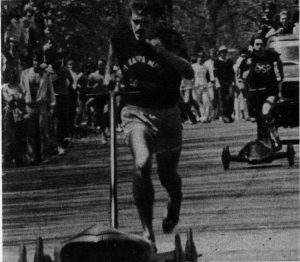
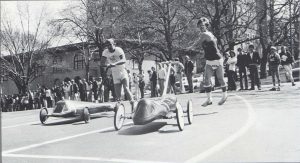
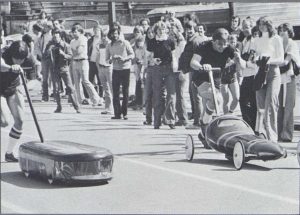
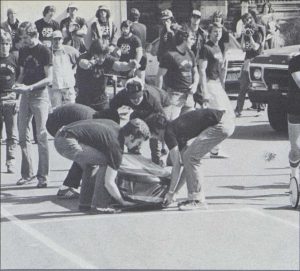
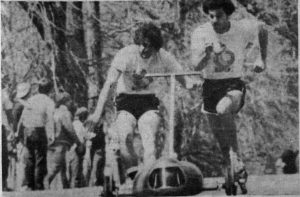
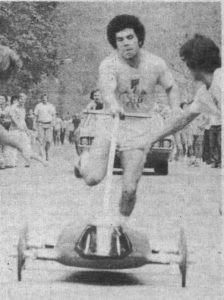
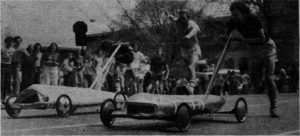
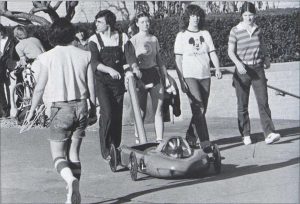

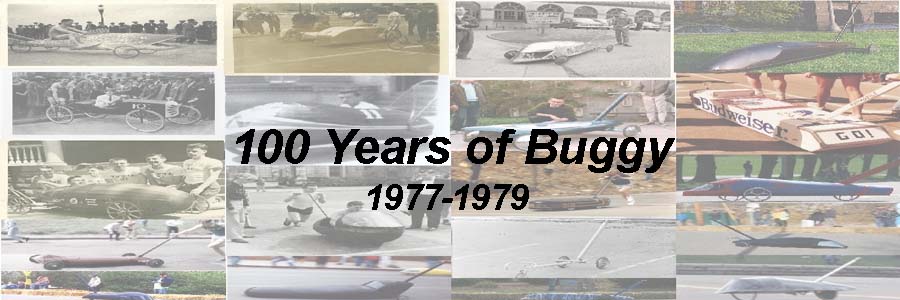
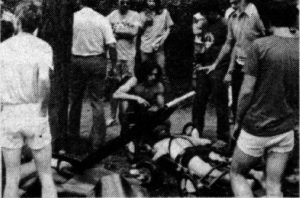
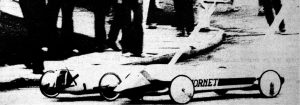
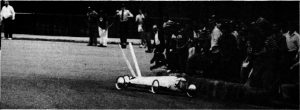


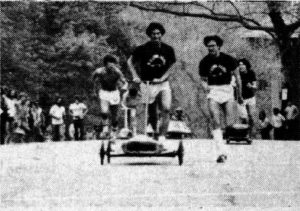
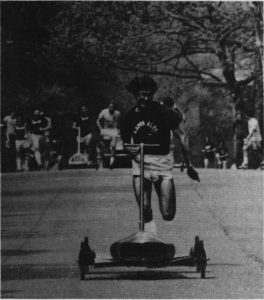
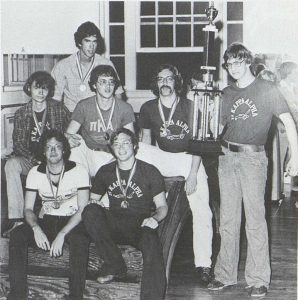
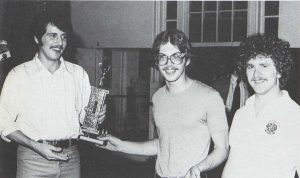
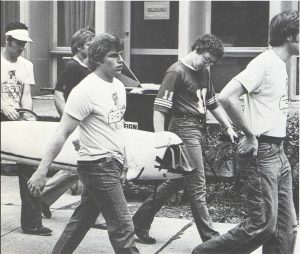
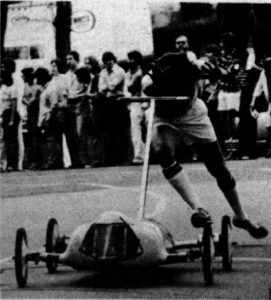
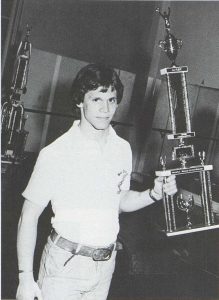
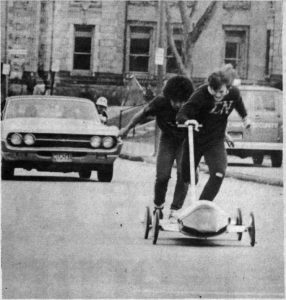
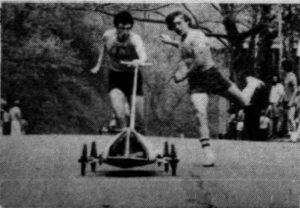
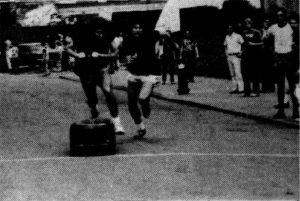
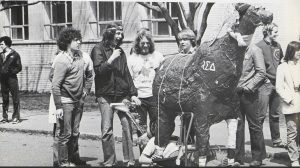
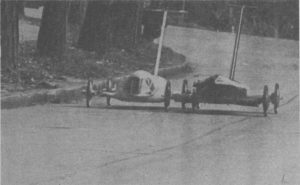
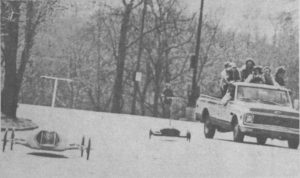

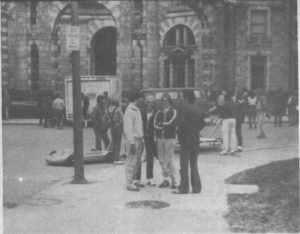
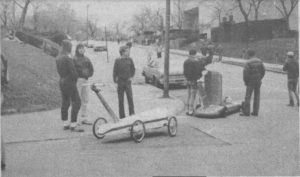

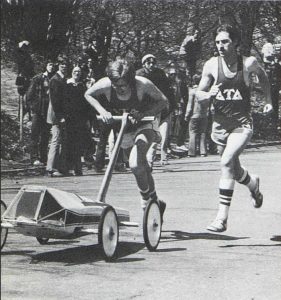

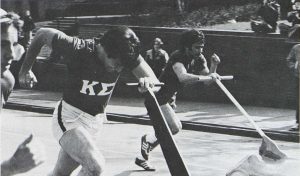


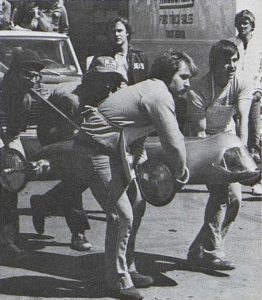
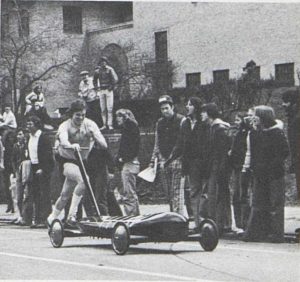

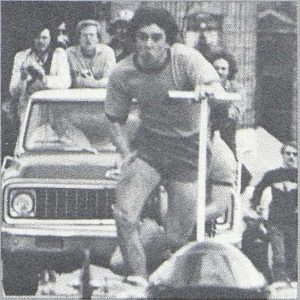

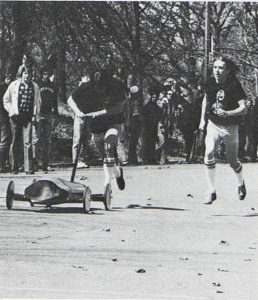

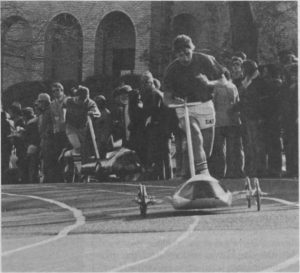
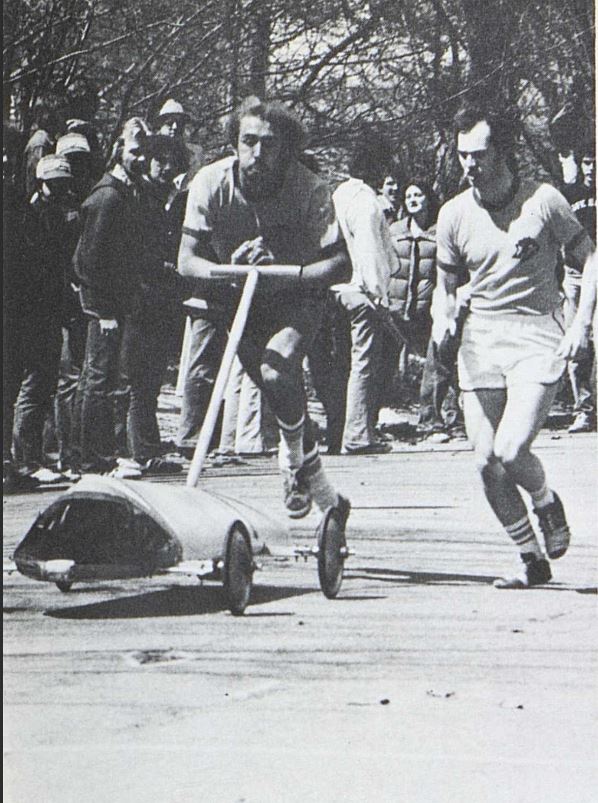
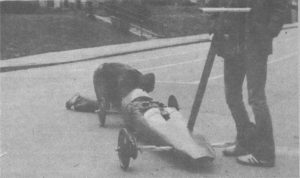
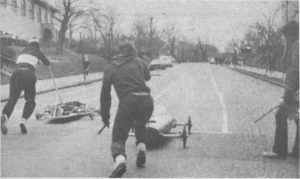
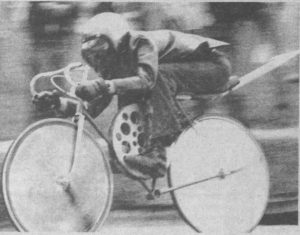
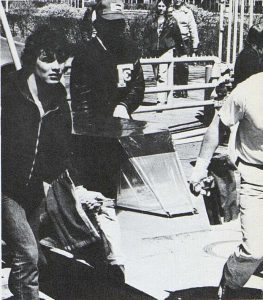
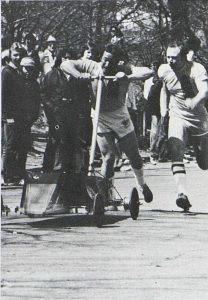
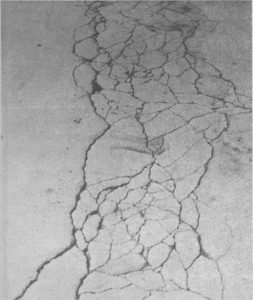


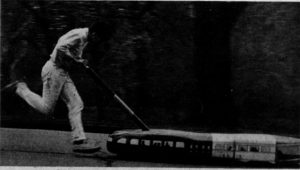
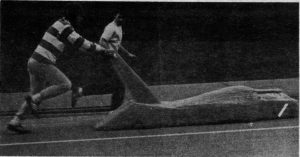

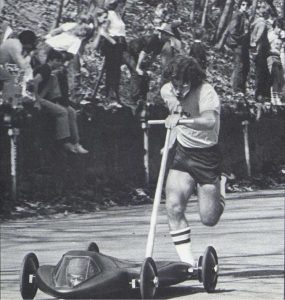
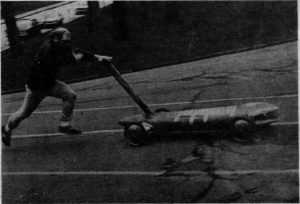

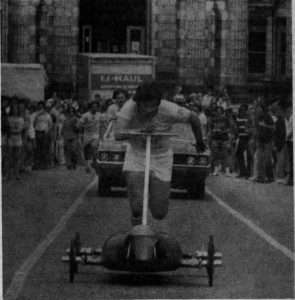

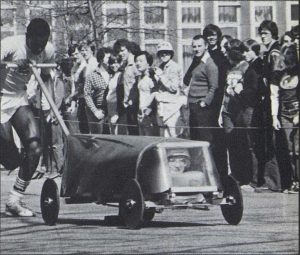
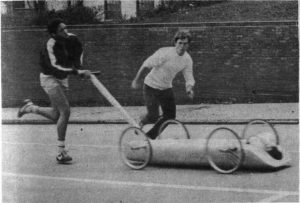
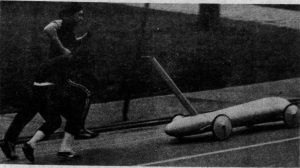
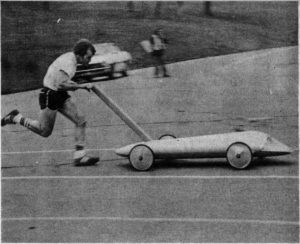
the Pope says:
I believe that Sigma Nu’s ‘esp’ was a new buggy in 78 or 79. History section on this site says 79. 79 buggy book has an entry by Sigma Nu that clearly indicated esp was a thing by then.
Bryan Arsham says:
I had ESP debuting in 1980, but you’re right – Between the Buggy Book and the t-shirt from 1979, it certainly seems like ESP probably debuted then. I’ll make the change, but if anyone can confirm (or if you can identify any ESP – or any other buggies – in the photos), let me know.
Elmo Zoneball says:
Some history corrections from 1977:
“Hustler” — whose design was not completed until Christmas time, was built and welded up over Spring Break, was an Al tube AND ladder frame — we literally bought a short aluminum ladder, drilled out the rivets, and threw away the rungs! The sides of the ladder were “C” section aluminum, and we used a flat frame of 1″ Al rectangular tubes to connect all the pieces together, with a small gusset plate welded in the center tying it all together.
It was crude, but effective, and weighed about 15 lbs less than “Intrepid,” and had much greater torsional stiffness, in spite of its design.
“New Ken Taxi” — aka — “the Limo” was not a new buggy at all: it was the 1974 vintage push practice buggy built over a single weekend by Bob Thomas and Tom Cianelli, with a new coat of paint. It was basically a rectangular plywood sheet, with solid wood side board for stiffness, using Soap Box Derby axles (steel,) and heavy angle iron for the frontal crash protection. It was large enough that Ethel Merman could have fit in it, and weighed about as much as she did. It was NEVER intended to be raced. The only reason it was entered was because the fraternity had a very large membership in this era, and so many members were participating in push practice that the ones who didn’t make A or B team demanded we let them run “Limo” as a “C ” team. We figured, “what’s the harm?” So we entered it. We never even changed the wheels or tires on race day from push practice all season. It was the ultimate “lead sled.”
Elmo Zoneball says:
Photo captions corrections:
“1978 – An unidentified buggy, possibly SigNu’s Scorpion (from the 04-25-1978 Tartan)”
That’s SAE’s “Intrepid” …
“1978 – SAE (possibly Intrepid) on the Back Hills (from the 1978 Thistle)”
Half right; it’s SAE’s “Hustler” (I’m the pusher on the right about to take the exchange and push Hill #5 — first time I’ve seen this photo.)
“1978 – An unidentified buggy enters the Freeroll (from the 1978 Thistle)”
That’s SAE’s “Intrepid” on Hill #2.
“1979 – Unidentified buggies entering the Freeroll (from the 04-24-1979 Tartan). This might be Prelims Heat 11, with PiKA A’s Pi-thon in Lane 2 and SAE B in Lane 1.”
Definitely SAE’s “Hustler” in lane #1.
“1979 – An unidentified buggy being pushed up Hill 1 (from the 1979 Thistle)”
SAE’s “Intrepid.”
Bryan Arsham says:
Elmo, this is amazing! Thank you so much! You’ve given us so much incite on the SAE buggies for 1977 that I’ve revised the 1977 section to give those two buggies their own bullet. And I’ve updated all of the captions accordingly (I’m glad to see that my guess of Prelims Heat 11 in 1979 was correct; my flaw with Intrepid was that I assumed it was still a white buggy, but from that photo in 1978, it had a pretty sleek design).
Just wondering, did you push for SAE A or SAE B in 1978?
Elmo Zoneball says:
In 1978, the “Hustler” would have been A team, and that’s what I pushed (Hill #5, as seen in the photo.)
BTW, “Elmo Zoneball” is not a real name; I just use it as a screen name. It’s origins are from the Freshmen pic Book published every year — members at SAE volunteered to layout the freshman pic book, and one of the inside jokes was to insert photos of ourselves when we were 12 years old, or dressed up as derelicts, and give them goofy names. That’s where “Elmo” and “Hugo Zoneball” came from, among many other fake names.
Elmo Zoneball says:
The “1978” video is not from 1978. It’s from the ’60s (guessing ’68.) The Beta buggy is “00” which never ran in the late ’70s.
Elmo Zoneball says:
The “1978” video is not from 1978. It’s from the ’60s (guessing ’68.) The Beta buggy is “00” which never ran in the late ’70s.
The “1977 Buggy at Design Competition” video is also not from the ’70s — that’s another ’60s 8mm film of what was one of the Beta buggies — likely the one that was rumored to have been designed and built by Beta alums at Alcoa. Note the pneumatic actuators on the brake system, a design feature that was unique to Beta, AFAIK. As I recall, they used the hollow pushbar as an air tank to pressurize the brake system.
Bryan Arsham says:
Thanks Elmo! I’ve revised the caption to note that “Elmo Zoneball” is your screen name. And your comment about the 1978 video makes me a little relieved. the reason the “buggies and heats” were unidentified is because they didn’t make any sense – They didn’t line up with what I knew about 1978 (2 bikes in the same heat did not happen in 1978). I’ve removed the videos from here, and I will move them to the appropriate article if/when I can determine the correct year.
Edit for those closely watching these comments: The video previously identified as 1978 was actually from 1966, and it has been moved to the 1964-1966 article.